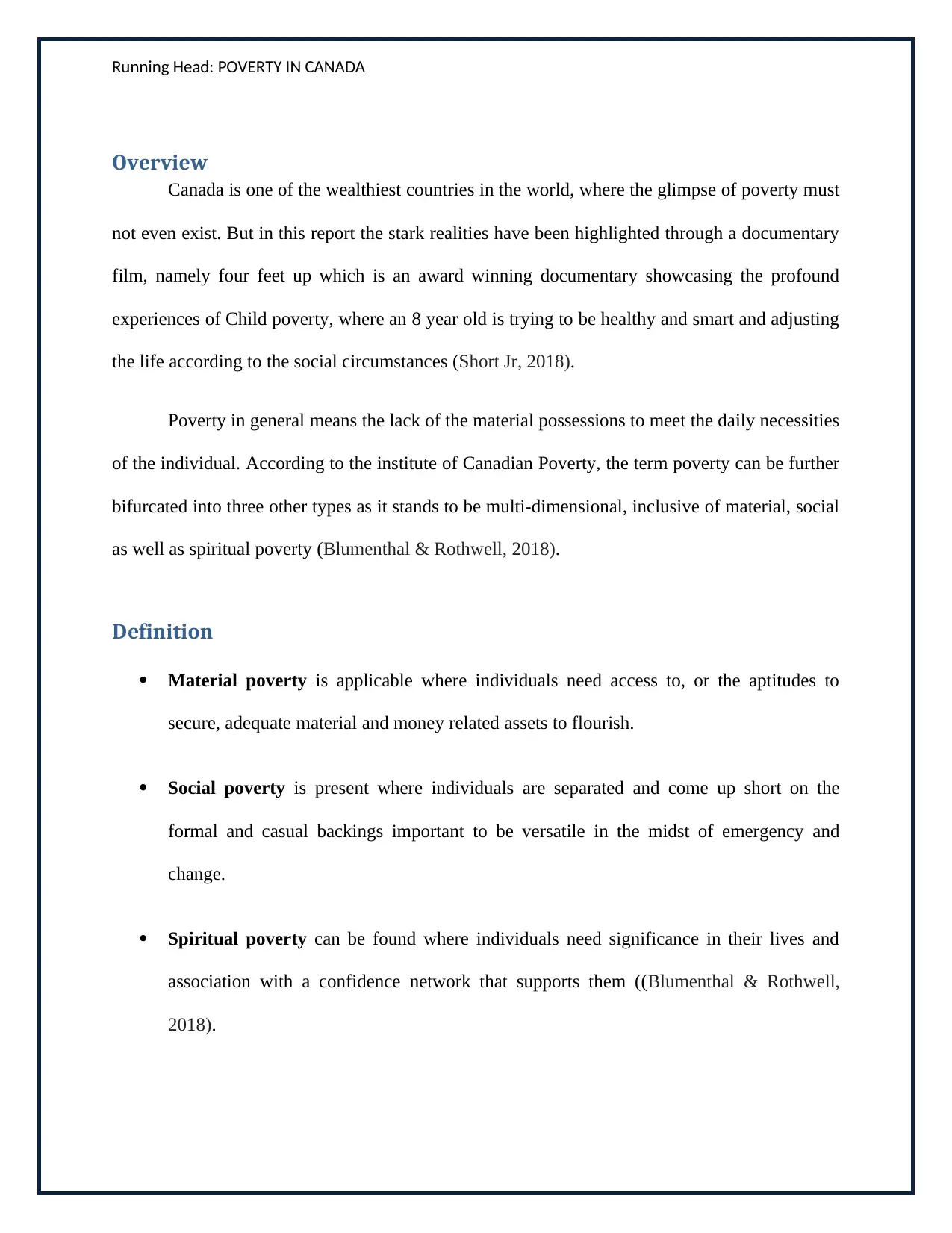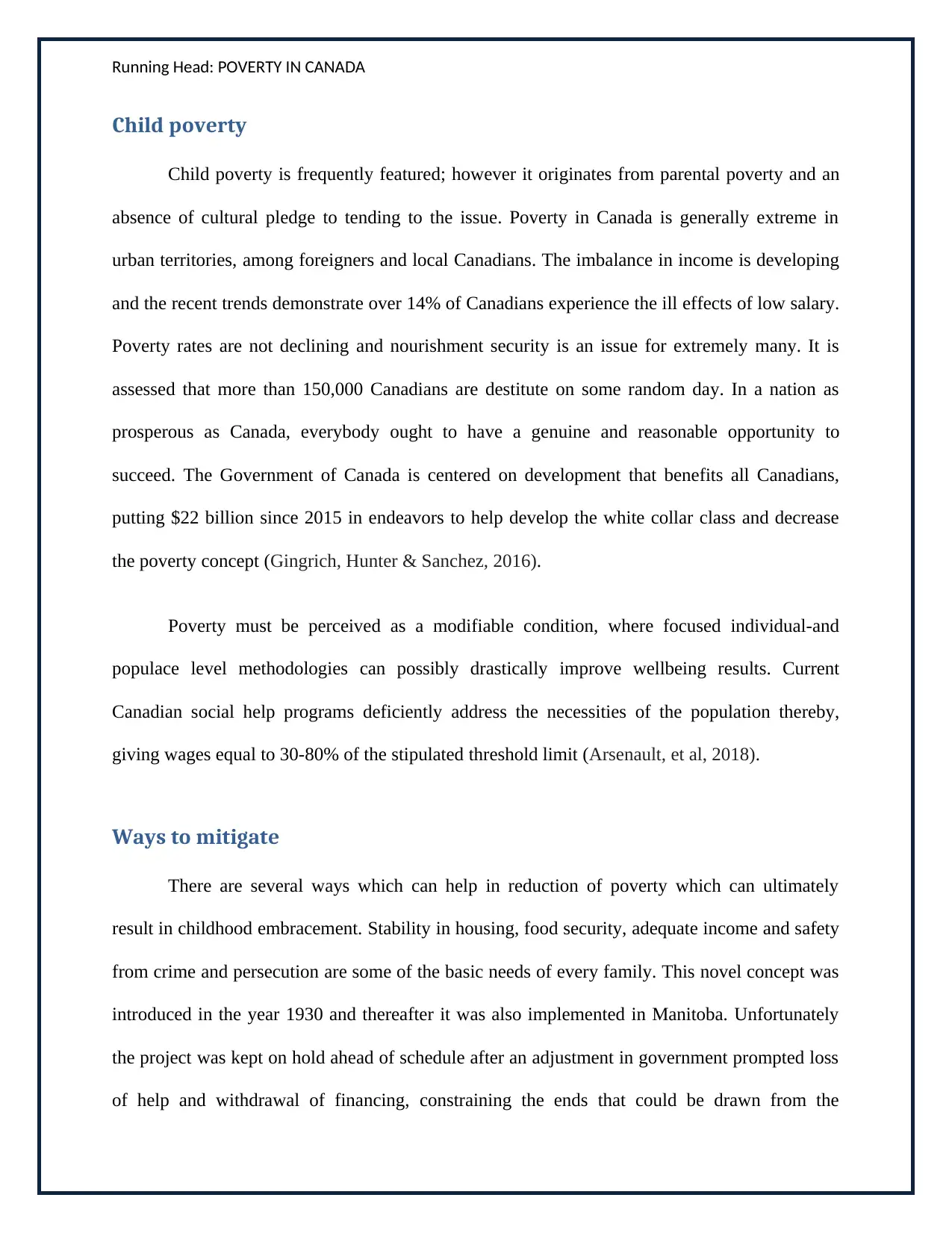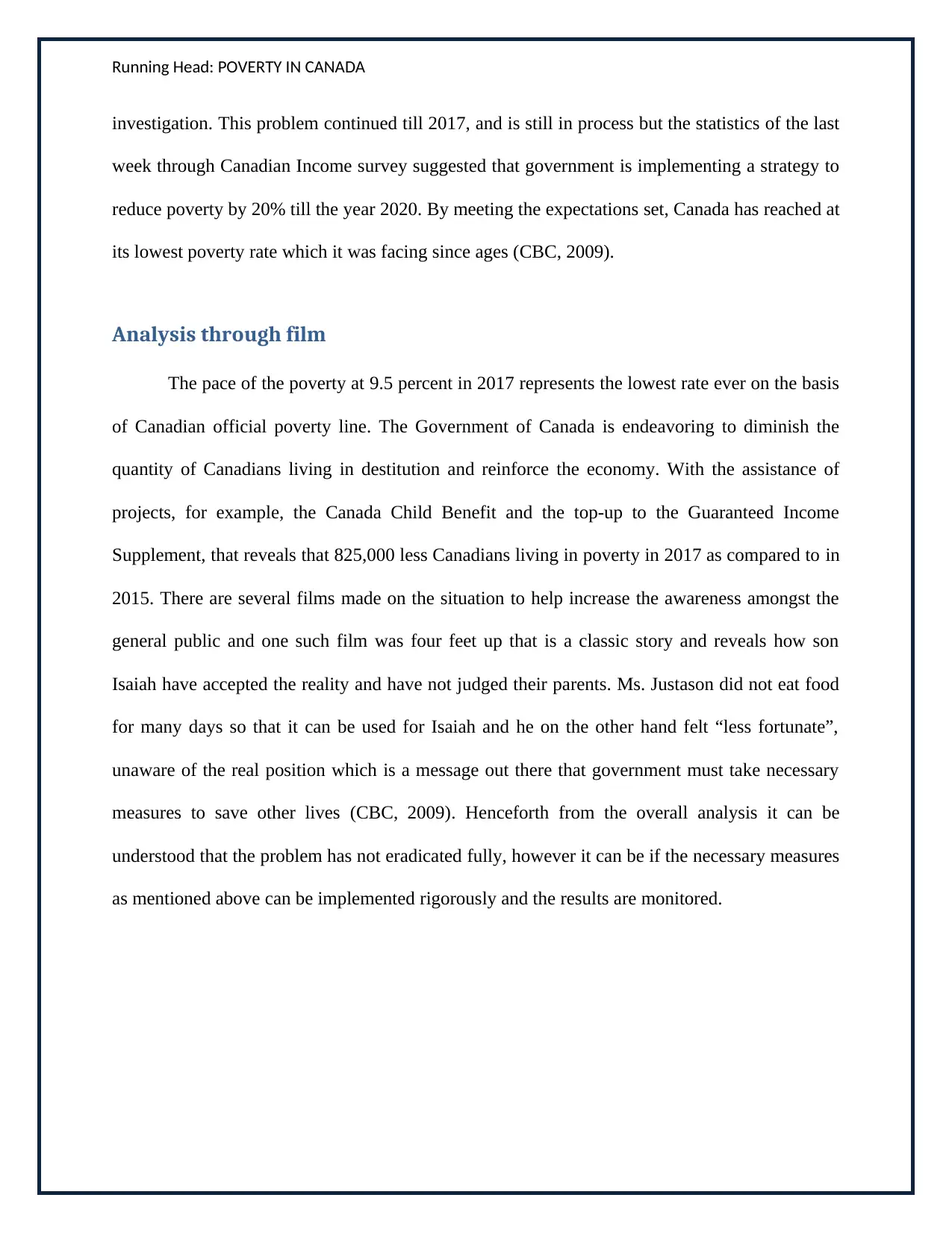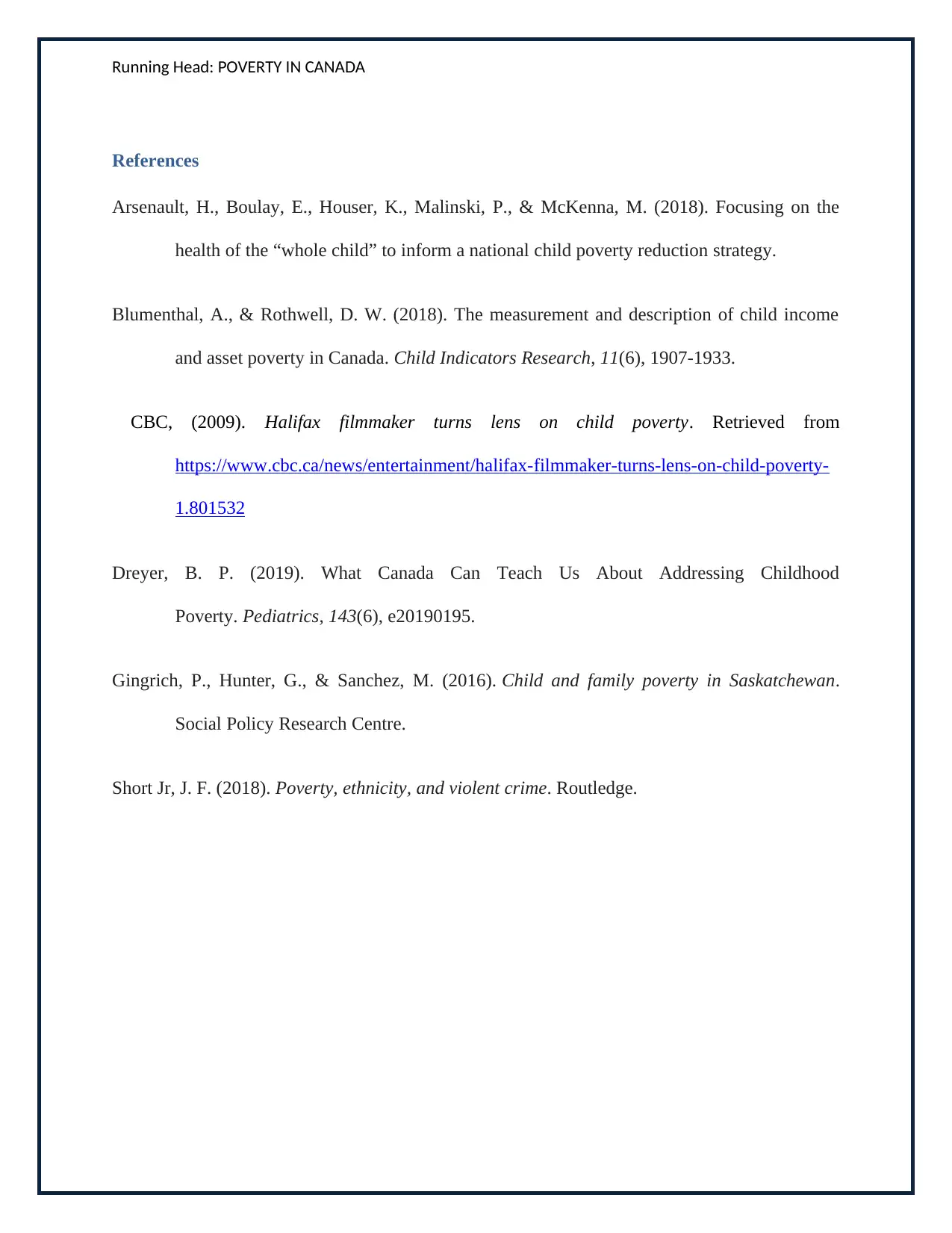Poverty in Canada: An Overview, Analysis and Mitigation Strategies
VerifiedAdded on 2022/09/05
|5
|1029
|23
Report
AI Summary
This report provides an overview of poverty in Canada, emphasizing the issue of child poverty and its various dimensions, including material, social, and spiritual aspects. It highlights the stark realities of poverty through the analysis of a documentary film, 'Four Feet Up,' which showcases the experiences of an 8-year-old child navigating poverty. The report discusses poverty rates, income inequality, and the government's efforts to reduce poverty through initiatives like the Canada Child Benefit. It also explores the importance of housing stability, food security, and adequate income as crucial factors in mitigating poverty. The analysis reveals that while progress has been made, poverty remains a significant challenge, and further rigorous implementation of effective measures is needed to address the issue comprehensively. The report references various studies and sources to support its findings, offering a comprehensive understanding of the complexities of poverty in Canada.

Running Head: POVERTY IN CANADA 1
POVERTY IN CANADA
POVERTY IN CANADA
Paraphrase This Document
Need a fresh take? Get an instant paraphrase of this document with our AI Paraphraser

Running Head: POVERTY IN CANADA
Overview
Canada is one of the wealthiest countries in the world, where the glimpse of poverty must
not even exist. But in this report the stark realities have been highlighted through a documentary
film, namely four feet up which is an award winning documentary showcasing the profound
experiences of Child poverty, where an 8 year old is trying to be healthy and smart and adjusting
the life according to the social circumstances (Short Jr, 2018).
Poverty in general means the lack of the material possessions to meet the daily necessities
of the individual. According to the institute of Canadian Poverty, the term poverty can be further
bifurcated into three other types as it stands to be multi-dimensional, inclusive of material, social
as well as spiritual poverty (Blumenthal & Rothwell, 2018).
Definition
Material poverty is applicable where individuals need access to, or the aptitudes to
secure, adequate material and money related assets to flourish.
Social poverty is present where individuals are separated and come up short on the
formal and casual backings important to be versatile in the midst of emergency and
change.
Spiritual poverty can be found where individuals need significance in their lives and
association with a confidence network that supports them ((Blumenthal & Rothwell,
2018).
Overview
Canada is one of the wealthiest countries in the world, where the glimpse of poverty must
not even exist. But in this report the stark realities have been highlighted through a documentary
film, namely four feet up which is an award winning documentary showcasing the profound
experiences of Child poverty, where an 8 year old is trying to be healthy and smart and adjusting
the life according to the social circumstances (Short Jr, 2018).
Poverty in general means the lack of the material possessions to meet the daily necessities
of the individual. According to the institute of Canadian Poverty, the term poverty can be further
bifurcated into three other types as it stands to be multi-dimensional, inclusive of material, social
as well as spiritual poverty (Blumenthal & Rothwell, 2018).
Definition
Material poverty is applicable where individuals need access to, or the aptitudes to
secure, adequate material and money related assets to flourish.
Social poverty is present where individuals are separated and come up short on the
formal and casual backings important to be versatile in the midst of emergency and
change.
Spiritual poverty can be found where individuals need significance in their lives and
association with a confidence network that supports them ((Blumenthal & Rothwell,
2018).

Running Head: POVERTY IN CANADA
Child poverty
Child poverty is frequently featured; however it originates from parental poverty and an
absence of cultural pledge to tending to the issue. Poverty in Canada is generally extreme in
urban territories, among foreigners and local Canadians. The imbalance in income is developing
and the recent trends demonstrate over 14% of Canadians experience the ill effects of low salary.
Poverty rates are not declining and nourishment security is an issue for extremely many. It is
assessed that more than 150,000 Canadians are destitute on some random day. In a nation as
prosperous as Canada, everybody ought to have a genuine and reasonable opportunity to
succeed. The Government of Canada is centered on development that benefits all Canadians,
putting $22 billion since 2015 in endeavors to help develop the white collar class and decrease
the poverty concept (Gingrich, Hunter & Sanchez, 2016).
Poverty must be perceived as a modifiable condition, where focused individual-and
populace level methodologies can possibly drastically improve wellbeing results. Current
Canadian social help programs deficiently address the necessities of the population thereby,
giving wages equal to 30-80% of the stipulated threshold limit (Arsenault, et al, 2018).
Ways to mitigate
There are several ways which can help in reduction of poverty which can ultimately
result in childhood embracement. Stability in housing, food security, adequate income and safety
from crime and persecution are some of the basic needs of every family. This novel concept was
introduced in the year 1930 and thereafter it was also implemented in Manitoba. Unfortunately
the project was kept on hold ahead of schedule after an adjustment in government prompted loss
of help and withdrawal of financing, constraining the ends that could be drawn from the
Child poverty
Child poverty is frequently featured; however it originates from parental poverty and an
absence of cultural pledge to tending to the issue. Poverty in Canada is generally extreme in
urban territories, among foreigners and local Canadians. The imbalance in income is developing
and the recent trends demonstrate over 14% of Canadians experience the ill effects of low salary.
Poverty rates are not declining and nourishment security is an issue for extremely many. It is
assessed that more than 150,000 Canadians are destitute on some random day. In a nation as
prosperous as Canada, everybody ought to have a genuine and reasonable opportunity to
succeed. The Government of Canada is centered on development that benefits all Canadians,
putting $22 billion since 2015 in endeavors to help develop the white collar class and decrease
the poverty concept (Gingrich, Hunter & Sanchez, 2016).
Poverty must be perceived as a modifiable condition, where focused individual-and
populace level methodologies can possibly drastically improve wellbeing results. Current
Canadian social help programs deficiently address the necessities of the population thereby,
giving wages equal to 30-80% of the stipulated threshold limit (Arsenault, et al, 2018).
Ways to mitigate
There are several ways which can help in reduction of poverty which can ultimately
result in childhood embracement. Stability in housing, food security, adequate income and safety
from crime and persecution are some of the basic needs of every family. This novel concept was
introduced in the year 1930 and thereafter it was also implemented in Manitoba. Unfortunately
the project was kept on hold ahead of schedule after an adjustment in government prompted loss
of help and withdrawal of financing, constraining the ends that could be drawn from the
⊘ This is a preview!⊘
Do you want full access?
Subscribe today to unlock all pages.

Trusted by 1+ million students worldwide

Running Head: POVERTY IN CANADA
investigation. This problem continued till 2017, and is still in process but the statistics of the last
week through Canadian Income survey suggested that government is implementing a strategy to
reduce poverty by 20% till the year 2020. By meeting the expectations set, Canada has reached at
its lowest poverty rate which it was facing since ages (CBC, 2009).
Analysis through film
The pace of the poverty at 9.5 percent in 2017 represents the lowest rate ever on the basis
of Canadian official poverty line. The Government of Canada is endeavoring to diminish the
quantity of Canadians living in destitution and reinforce the economy. With the assistance of
projects, for example, the Canada Child Benefit and the top-up to the Guaranteed Income
Supplement, that reveals that 825,000 less Canadians living in poverty in 2017 as compared to in
2015. There are several films made on the situation to help increase the awareness amongst the
general public and one such film was four feet up that is a classic story and reveals how son
Isaiah have accepted the reality and have not judged their parents. Ms. Justason did not eat food
for many days so that it can be used for Isaiah and he on the other hand felt “less fortunate”,
unaware of the real position which is a message out there that government must take necessary
measures to save other lives (CBC, 2009). Henceforth from the overall analysis it can be
understood that the problem has not eradicated fully, however it can be if the necessary measures
as mentioned above can be implemented rigorously and the results are monitored.
investigation. This problem continued till 2017, and is still in process but the statistics of the last
week through Canadian Income survey suggested that government is implementing a strategy to
reduce poverty by 20% till the year 2020. By meeting the expectations set, Canada has reached at
its lowest poverty rate which it was facing since ages (CBC, 2009).
Analysis through film
The pace of the poverty at 9.5 percent in 2017 represents the lowest rate ever on the basis
of Canadian official poverty line. The Government of Canada is endeavoring to diminish the
quantity of Canadians living in destitution and reinforce the economy. With the assistance of
projects, for example, the Canada Child Benefit and the top-up to the Guaranteed Income
Supplement, that reveals that 825,000 less Canadians living in poverty in 2017 as compared to in
2015. There are several films made on the situation to help increase the awareness amongst the
general public and one such film was four feet up that is a classic story and reveals how son
Isaiah have accepted the reality and have not judged their parents. Ms. Justason did not eat food
for many days so that it can be used for Isaiah and he on the other hand felt “less fortunate”,
unaware of the real position which is a message out there that government must take necessary
measures to save other lives (CBC, 2009). Henceforth from the overall analysis it can be
understood that the problem has not eradicated fully, however it can be if the necessary measures
as mentioned above can be implemented rigorously and the results are monitored.
Paraphrase This Document
Need a fresh take? Get an instant paraphrase of this document with our AI Paraphraser

Running Head: POVERTY IN CANADA
References
Arsenault, H., Boulay, E., Houser, K., Malinski, P., & McKenna, M. (2018). Focusing on the
health of the “whole child” to inform a national child poverty reduction strategy.
Blumenthal, A., & Rothwell, D. W. (2018). The measurement and description of child income
and asset poverty in Canada. Child Indicators Research, 11(6), 1907-1933.
CBC, (2009). Halifax filmmaker turns lens on child poverty. Retrieved from
https://www.cbc.ca/news/entertainment/halifax-filmmaker-turns-lens-on-child-poverty-
1.801532
Dreyer, B. P. (2019). What Canada Can Teach Us About Addressing Childhood
Poverty. Pediatrics, 143(6), e20190195.
Gingrich, P., Hunter, G., & Sanchez, M. (2016). Child and family poverty in Saskatchewan.
Social Policy Research Centre.
Short Jr, J. F. (2018). Poverty, ethnicity, and violent crime. Routledge.
References
Arsenault, H., Boulay, E., Houser, K., Malinski, P., & McKenna, M. (2018). Focusing on the
health of the “whole child” to inform a national child poverty reduction strategy.
Blumenthal, A., & Rothwell, D. W. (2018). The measurement and description of child income
and asset poverty in Canada. Child Indicators Research, 11(6), 1907-1933.
CBC, (2009). Halifax filmmaker turns lens on child poverty. Retrieved from
https://www.cbc.ca/news/entertainment/halifax-filmmaker-turns-lens-on-child-poverty-
1.801532
Dreyer, B. P. (2019). What Canada Can Teach Us About Addressing Childhood
Poverty. Pediatrics, 143(6), e20190195.
Gingrich, P., Hunter, G., & Sanchez, M. (2016). Child and family poverty in Saskatchewan.
Social Policy Research Centre.
Short Jr, J. F. (2018). Poverty, ethnicity, and violent crime. Routledge.
1 out of 5
Your All-in-One AI-Powered Toolkit for Academic Success.
+13062052269
info@desklib.com
Available 24*7 on WhatsApp / Email
![[object Object]](/_next/static/media/star-bottom.7253800d.svg)
Unlock your academic potential
Copyright © 2020–2025 A2Z Services. All Rights Reserved. Developed and managed by ZUCOL.


